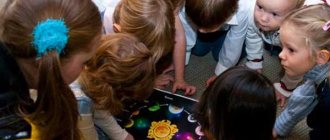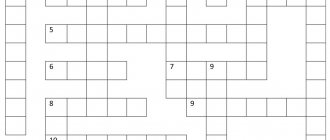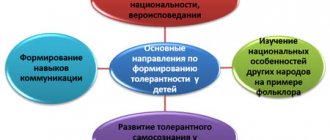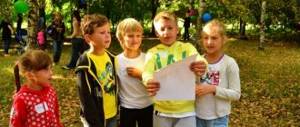Quest for the little ones. And what is this?
Until recently, quest was perceived as an ordinary computer game. Completed the task (found, deciphered, identified, deciphered, solved) - receive a prize and move to the next level.
But time passed and the computer quest acquired a competitor - a live quest. The prototype of the live quest is “Fort Boyard”, the realities of which were followed by almost every resident of Russia.
Well, what does this have to do with a quest for kids? Let's try to figure it out.
To make it interesting for everyone
When choosing a topic and tasks for a home quest, do not forget to take into account the age and individual characteristics of the child.
Quest for children 4–5 years old
The game should not tire the baby or bore him, therefore:
- The quest will take no more than 30 minutes.
- Carefully consider the theme; children of this age are close to: fairy tales, New Year's gifts, animals, music.
- The tasks should be feasible and interesting, based on the child’s ability to navigate in space, perform basic tasks on fine motor skills, arrange pictures in sequence, assemble parts into a whole, build according to a model, do shading, and paint.
- Logical competitions must be alternated with physical activity.
- It is recommended to use more colorful illustrations, pictures and decorations, since children of this age have visual-figurative thinking.
- Not all five-year-olds can read, so it’s best to provide assignments and prompts in the form of pictures or audio explanations.
If it is difficult for a child to get comfortable in an unfamiliar company, he can participate together with his mother.
Children's quest for 7–9 years old
The leading activity is still the game, but it needs to be organized competently:
- The high activity of children of this age, combined with increased fatigue, requires frequent changes of activities. Therefore, as with younger children, we alternate tasks for intelligence with physical exercises. The game should not last longer than 40 minutes.
- Logic, abstract thinking, speech, and eye development develop, which becomes the basis for complicating tasks. But all of them must be solvable, otherwise the child will lose all interest in the game.
- The attention of younger schoolchildren quickly dissipates, so quest tasks should not be drawn out in time; if necessary, it is worth recalling the essence of the test.
Children of this age are characterized by increased emotionality and receptivity. Therefore, an adult must be vigilant in order to prevent conflicts and praise and support the baby in a timely manner.
Quest for children 10–13 years old
This age coincides with the onset of puberty, so the hormonal background of the child’s body is unstable, which should be taken into account when choosing quest tests:
- Due to increased fatigue, monotonous tasks or those involving excessive physical activity are not suitable for children.
- The nervous system of middle-aged participants is very sensitive. Therefore, you should avoid excessive passions, violent emotions, and conflict situations.
- The duration of the quest can be increased to an hour by including seven to eight stages.
- Topics should be selected taking into account the interests of the child.
The principles of organizing quests at any age should be their safety, the absence of elements of horror or violence that traumatize the child’s psyche, as well as mandatory adult supervision.
It is included in the kit
- Instructions
- Task cards (9 tasks/18 caches). The text is adapted separately for one participant and for a group.
- Envelope
- Starting and final messages from the brownie. Templates for editing (for your own version of the legend).
The material is provided electronically in pdf format (each card on a separate A4 sheet) and will be available for download immediately after payment . Please check the accuracy of the specified e-mail. You will have to print everything yourself on a printer in color (preferably) or black and white.
The cost of the quest “Surprise from the Brownie” is only 70 rubles.
if the button does not work, copy and paste this link into the address bar of your browser, press enter: https://payform.ru/gn2vYb/
Before placing an order, you can read the frequently asked questions.
If suddenly something didn’t work out, or there is no suitable payment method , then leave a comment on this article, or write to us by email [email protected] or in the VKontakte group. Our administrator will contact you shortly.
Our summer quest! (3 years)
- Seal
Details Author: Nalivaykina Lyudmila Published July 27, 2013
Staying at home in the summer is simply a crime. I want to spend as much time as possible outside and for walks.
What about developmental activities? The answer suggests itself - you can combine a walk and the development of a child.
Personally, I did just that this summer, which is what I want to tell you about in this article...
I’ll say right away that due to my daughter’s character traits, the option of laying out a rug on the street, taking cards and workbooks with tasks and asking Dasha to do what I had planned for her was not suitable for us. Unfortunately, she belongs to that category of children who often refuse to study and simply run away to another room if they are asked to complete some task, even if it is super interesting and exciting... Therefore, we constantly have to come up with something...
And I came up with an idea.
This summer we started conducting educational activities outside in the form of a quest. And we really liked it! Here's how it happened for us:
While going for a walk, we looked into the mailbox...
Something unusual was waiting for us there... Namely, a real letter! (Nowadays, a real paper letter in an envelope is gradually turning into a curiosity...).
To whom did it come?
We tried to read what was written on the envelope...
Wow!
This letter is addressed to Dasha! And it was sent not by anyone, but by Kinder Surprise himself!!!!!!!!!! Wow!
And he wrote the following:
And the map is attached:
Well, what can you do... Kinder will have to help out! We carefully studied our route and hit the road.
The map suggested that we first leave the house and go down the stairs... So, we already did that.
Then we had to find something under the bench...
What was there? Exercise!
Help the cat get to the kitten - build a path for her according to the pattern!
Execution process:
We completed the task, we can move on!
And then it was necessary to get to the fire trucks (they are installed on our playground... Moreover, the careless builders did not fantasize for a long time, but stupidly installed six identical fire trucks throughout the entire site).
We got to the fire trucks. The second task awaited us in the fire truck:
Count the fire trucks and put the correct number on the card.
We completed the task...
Where to go?
Go to the pond, find a large stone:
Here is the pond... but where is the stone?
Found it!
Our task is to write the word “stone” (circle the silhouettes of the letters). We did it!
Well, the very last task is to look for a Christmas tree!
Where is she?
Found it! And under it is our kinder!
Hooray!
That's it! It is done! Time to go home!
Results:
This summer we conducted a lot of similar quests. When we got tired of rescuing the kinder, we started playing according to fairy tales - helping the goat look for the lost kids using a map (when we found the kid, he didn’t want to go with us until we helped him complete his tasks), helping the little goat get to his grandparents, etc. d.
Personally, our quests have greatly simplified my preparation for developmental classes. As I already wrote, my daughter, like many children, refuses to complete even the most interesting tasks if you simply ask her to complete them... Therefore, every time I have to rack my brains over the question of how to involve her in developmental activities, how to present her with this or that a different task so that she actually completes it and does not run away to another room.
In the case of the quest, I no longer needed to come up with anything special. I simply selected tasks that interested me, drew a map, wrote a letter, and that was enough.
This is how we developed this summer...
What interesting things happened to you? Share ideas and links to your blogs in the comments.
Don't forget to bookmark it! Click on your social network button!
10+ quests for children aged 4-5 years
Children's entertainment is a whole business industry! An animator, for example, earns as much in an hour as a cardiac intensive care doctor earns in a day. Decent prices these days for quests too. But, I must admit, the topic is interesting. At least the children squeak from all these fortboyards. Quests have appeared in museums, parks, and in every self-respecting baby party company. You can order them for school, at the dacha, or even in the forest. But today we are talking about something a little different. There are specially equipped centers where you come with a group and find yourself in a whole fairy-tale world with its own secrets, secret locks and other mysteries. Most often, quests are developed for older children and adults, but there are also places for kids 4+ to practice their logic and intelligence. We are very impressed by some of the items in our selection. So let's get started.
1. Questopoly on Aviamotornaya (1st Enthusiastov Street) Two quests that will be interesting for both 4+ and 8+: – “Alice in Wonderland” – very colorful, spacious, as many as 10 rooms, including even a mirror maze; – “Run through the Jungle” - active, sporty, with ropes, vines and other monkey joys








